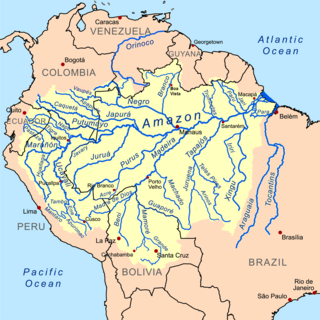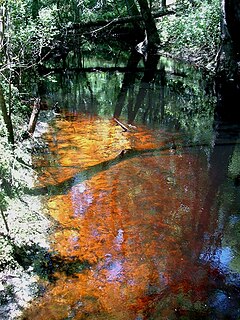
The Amazon River in South America is the largest river by discharge volume of water in the world, and the disputed second longest river in the world.

The Amazon rainforest, alternatively, the Amazon jungle or Amazonia, is a moist broadleaf tropical rainforest in the Amazon biome that covers most of the Amazon basin of South America. This basin encompasses 7,000,000 km2 (2,700,000 sq mi), of which 5,500,000 km2 (2,100,000 sq mi) are covered by the rainforest. This region includes territory belonging to nine nations and 3,344 formally acknowledged indigenous territories.

The Amazon Basin is the part of South America drained by the Amazon River and its tributaries. The Amazon drainage basin covers an area of about 6,300,000 km2 (2,400,000 sq mi), or about 35.5 percent of the South American continent. It is located in the countries of Bolivia, Brazil, Colombia, Ecuador, French Guiana (France), Guyana, Peru, Suriname, and Venezuela.

The Tapajós is a river in Brazil. It runs through the Amazon Rainforest and is a major tributary of the Amazon River. When combined with the Juruena River, the Tapajós is approximately 2,080 km (1,290 mi) long. It is one of the largest clearwater rivers, accounting for about 6% of the water in the Amazon basin.

A blackwater river is a type of river with a slow-moving channel flowing through forested swamps or wetlands. As vegetation decays, tannins leach into the water, making a transparent, acidic water that is darkly stained, resembling black tea. Most major blackwater rivers are in the Amazon Basin and the Southern United States. The term is used in fluvial studies, geology, geography, ecology, and biology. Not all dark rivers are blackwater in that technical sense. Some rivers in temperate regions, which drain or flow through areas of dark black loam, are simply black due to the color of the soil; these rivers are black mud rivers. There are also black mud estuaries.

The North Region of Brazil is the largest Region of Brazil, corresponding to 45.27% of the national territory. It is the least inhabited of the country, and contributes with a minor percentage in the national GDP and population. It comprises the states of Acre, Amapá, Amazonas, Pará, Rondônia, Roraima and Tocantins.

The violaceous jay is a species of bird in the family Corvidae, the crows and their allies.
A manatee is a large, fully aquatic marine mammal sometimes known as the "sea cow".
Amazonian Jews is the name for the mixed-race people of Jewish Moroccan and indigenous Amazonian Amerindian descent who live in the Amazon basin cities and river villages of Brazil and Peru, including Belém, Santarém, Alenquer, Óbidos, and Manaus in Brazil and Iquitos in Peru. Moroccan Jewish migrants, all men, arriving during the rubber boom, married indigenous Amazonian Amerindian women, and their current descendants are of mixed ancestry (mestizo). In the 21st century, Belém has about 1,000 Jewish families and Manaus about 140 such families, most descended from these 19th-century Moroccans.
The Amazon rainforest is the largest rainforest in the world, covering an area of 6,000,000 km². It represents over half of the planet's rainforests, and comprises the largest and most biodiverse tract of tropical rainforest in the world. This region includes territory belonging to nine nations. The majority of the forest is contained within Brazil, with 60%, followed by Peru with 13%, Colombia with 10%, and with minor amounts in Venezuela, Ecuador, Bolivia, Guyana, Suriname and French Guiana.
Amazonia refers to the Amazon rainforest.
Amazon usually refers to:
An immense number of bird species live in the Amazon rainforest and river basin. Over 1,300 of these species are types of birds, which accounts for one-third of all bird species in the world. The diets of rainforest birds greatly differ between species, although, nuts, fruits and leaves are a common food for many birds in the Amazon. Birds migrate to the Amazon rainforest from the North or South. Amazon birds are threatened by deforestation since they primarily reside in the treetops. At its current rate of destruction, the rainforest will be gone in forty years. Human encroachment also negatively affects the habitat of many Amazonian birds. Agriculture and road clearings limits the habitable areas. Birds in the Amazon are distinguished by which layer of the rainforest they reside in. Each layer or community has unique plants, animals and ecosystems. Birds interact with other animals in their community through the food chain, competition, mating, altruism and symbiosis.
A várzea forest is a seasonal floodplain forest inundated by whitewater rivers that occurs in the Amazon biome. Until the late 1970s, the definition was less clear and várzea was often used for all periodically flooded Amazonian forests.

The Amazon biome contains the Amazon rainforest, an area of tropical rainforest, and other ecoregions that cover most of the Amazon basin and some adjacent areas to the north and east. The biome contains blackwater and whitewater flooded forest, lowland and montane terra firme forest, bamboo and palm forest, savanna, sandy heath and alpine tundra. Some areas are threatened by deforestation for timber and to make way for pasture or soybean plantations.

The Campos Amazônicos National Park is a National park in the states of Rondônia, Amazonas and Mato Grosso, Brazil.
Candelaria Formation may refer to:
White Native Americans may refer to:








